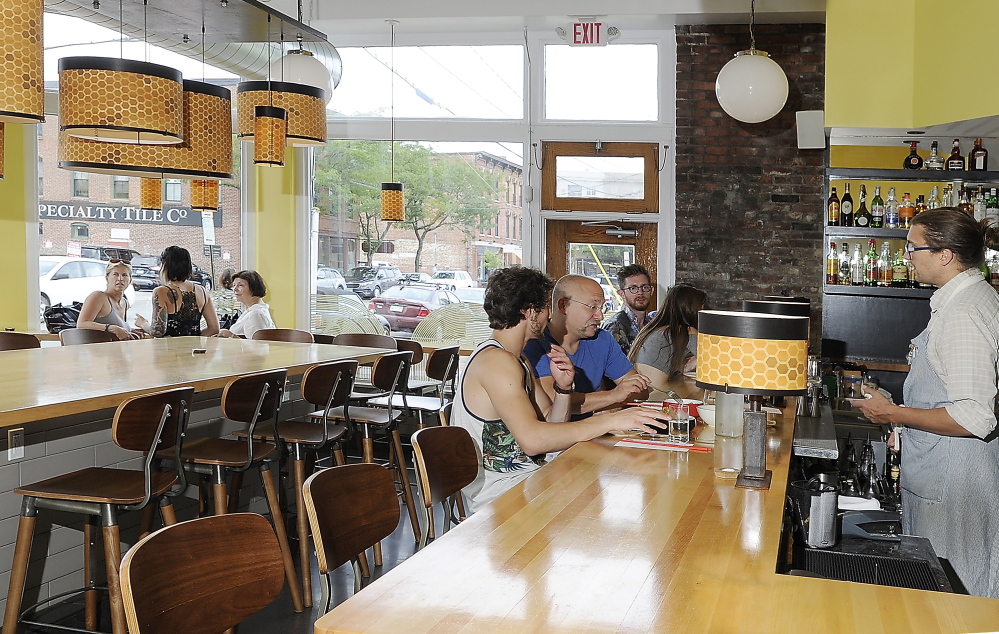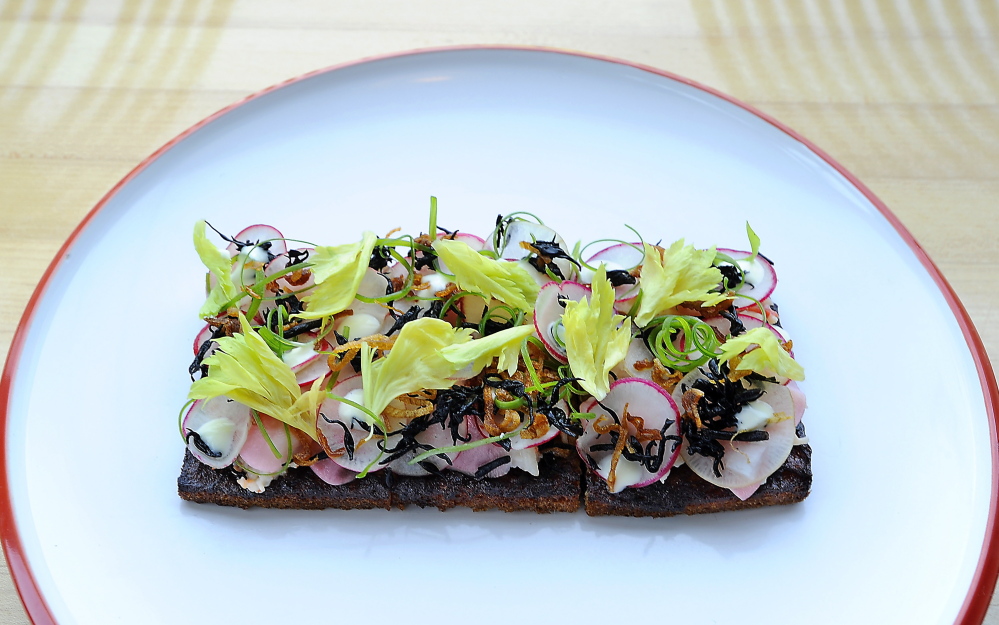A chef once told me that restaurants are a lot like relatives. There are those you visit frequently and always enjoy, a few you see only on special occasions, and several you tolerate. If you’re lucky, though, there are one or two you want to know better. Sure, they have a few quirks, but they’re bright, creative, known for their good taste, and filled with such energy that you look forward to your next encounter.
The Honey Paw is that last kind of restaurant. The latest venture from Andrew Taylor, Mike Wiley and Arlin Smith, who also own Hugo’s and Eventide Oyster Co. next door, it’s a stylish, laid-back, sun-filled noodle bar (the website says they serve “pastas from across the globe … dishes that borrow traditions, styles, and techniques from a variety of sources and locales”) with a menu that includes appetizers ideal for sharing; five or six hot and cold house-made noodle bowls, from ravioli to soba; and several larger dishes available only after 5 p.m.
To brace myself for an evening of carbs, I started with vegetables: wok-fried greens from Stone Cipher Farm ($9) in Bowdoinham. (“Good choice,” said the friendly young waitress, who was taking orders and occasionally flipping LPs on the turntables near the front door.) They arrived moments later – a glistening, emerald mound of young greens served atop a celery root puree tinted orange with harissa chili paste.
I lifted a few of the leaves with a bright-red pair of chopsticks – color rules at The Honey Paw – and nibbled. They were wonderfully salty, slightly crunchy and earthy (so earthy there was a stick among them, but I hardly cared) with a delicate peppery taste and not a hint of bitterness. On my next bite, I discovered pieces of sunflower and hazelnut, part of a spice blend that added depth to the plate. If you have kids (or grownups) who won’t eat their vegetables, this is a dish to savor.
So is lobster tartine ($15), a thin piece of yeast bread slathered with a mousse made from lobster and scallops, then fried a deep golden brown and topped with shreds of fresh lobster and translucent rounds of radish. Let’s be honest: Maine restaurants serve lobster. Sometimes it’s steamed. Sometimes it’s boiled. You’ve had it picked. You’ve had it whole. You’ve had it with mac ‘n’ cheese. But rarely is it treated as artfully as at The Honey Paw.
This appetizer (the brainchild of Taylor, Wiley and chef de cuisine Thomas Pisha-Duffly) is ravishing to look at – an oceanic version of the shingled fruit galette you might see in the window of a French patisserie but decorated here with tender, yellow celery leaves, fried shallot, and crunchy bits of hijiki, the nearly black Asian sea vegetable.
With some hesitation – should I taste this or photograph it? – I bit into the tartine. It was softer than expected – the bread practically melted on my tongue – and the lobster tasted sweet and slightly lemony. But it was the contrasts I liked best: velvety shellfish mousse set off by crunchy slivers of radish; grassy celery leaves against briny hijiki. The sum of the parts – delicious.
Hard as it was to tear myself away from the tartine, I stopped to look around. The restaurant is compact but inviting, with a bar and 10 stools set against the back wall, a large communal table in the center of the room, and 14 more stools lining the windows overlooking Middle Street and an open space next door. A few couples were seated at small tables outside, and two waitresses moved between them, casually taking orders (they tote electronic tablets; the restaurant has a modern aesthetic so there are no paper pads here) and answering questions about the menu and the specials scrawled on a transparent panel near the front door.
I wanted to know about dolsot bibimbap ($29), not a noodle dish, but a Korean staple with rice, beef, kimchi and pickled vegetables served in a blisteringly hot earthenware bowl. “One of our most popular dishes,” the waitress said. “The skewered beef is beyond belief.” She had a point. Juicy, slightly sweet and appealingly salty, the tender chunks of beef were outstanding, especially with a drop of gochuchang, a pungent, piquant, fermented chili paste. I used my chopstick to pierce the yolk of a fried egg, then speared a length of pickled daikon, a piece of spicy cabbage and a few grains of crunchy rice from the bottom of the bowl. Each morsel was distinct and flavorful, but again the joy was in the mix.
I couldn’t wait to try one of the kitchen’s signature noodle dishes, chilled soba ($14) with nori, peanuts and a mushroom dipping sauce. The bowl arrived on a large wooden board (bark and all) and was piled with buckwheat noodles and paper-thin shreds of nori, the black-green sheets of seaweed. But the subtle sweetness that was so compulsively good in the bibimbap and the tartine seemed overpowering here. I liked the noodles – they were slightly nutty and chewy; the dipping sauce, though, paled in comparison.
I much preferred the udon noodles ($15), a steaming bowl filled with thick, sturdy noodles, chunks of fatty pork belly and a sunset-colored tonkotsu ramen broth. That broth – so rich and creamy it was nearly a sauce – was concentrated and meaty, like a stew that had been bubbling on the stove for hours. (When I asked Mike Wiley about it, he laughed and said, “It does boil for hours.… We let pork bones and marrow boil away to coax out all the collagen and flavor we can.”) The finished broth is so lush and luscious, it didn’t need the yolk of another fried egg on top to add yet another layer of richness (not that I’m complaining). I slurped salty spoonfuls, happily fishing for shreds of kimchi and cubes of pork.
You can’t help but notice the layers of details at The Honey Paw: the tiny wooden salt cellars on the counters, the red-and-black lacquered spoons, the chiffonade of seaweed decorating noodle bowls, the honeycomb pattern on the light fixtures – even the metal tray on which the waitress delivers your bill, held in place by a minuscule magnet that looks straight off a Parcheesi board. These exacting details extend to the restroom – the Zen-like sinks decorated with river rock, and the vintage black-and-white images of pasta makers lining the walls. (Those photographs were a gift from a longtime customer whose family once owned a pasta factory in New York state.)
A few things to keep in mind. The restaurant has been open for only three months, and service can occasionally seem, well, leisurely. The beautiful light admitted by those huge windows means you may want to bring sunglasses at lunchtime – or ask the waitress to lower the shades. And, whether it’s the music playing on one of the turntables near the door or the acoustics of the space itself (the dining room has a pressed tin ceiling), the restaurant can grow noisy.
But casual pacing and buzz are part of The Honey Paw’s winning personality. I’m not waiting for a special occasion or a family holiday. I’ll be back again soon.
James H. Schwartz has covered food, travel and architecture for The Washington Post, Downeast, Coastal Living and Southern Living magazines for more than 30 years. Long a commuter between Portland and Washington, D.C., he retired from his job as vice president at the National Trust for Historic Preservation in 2013 and relocated to Maine.
Send questions/comments to the editors.



